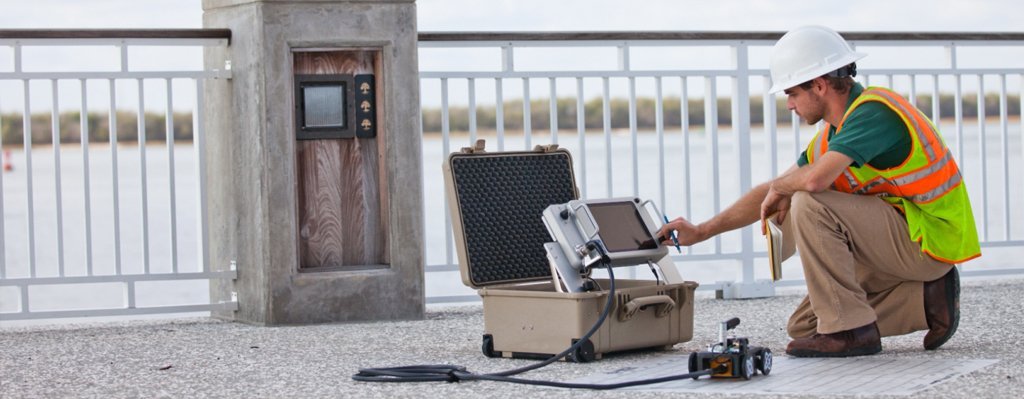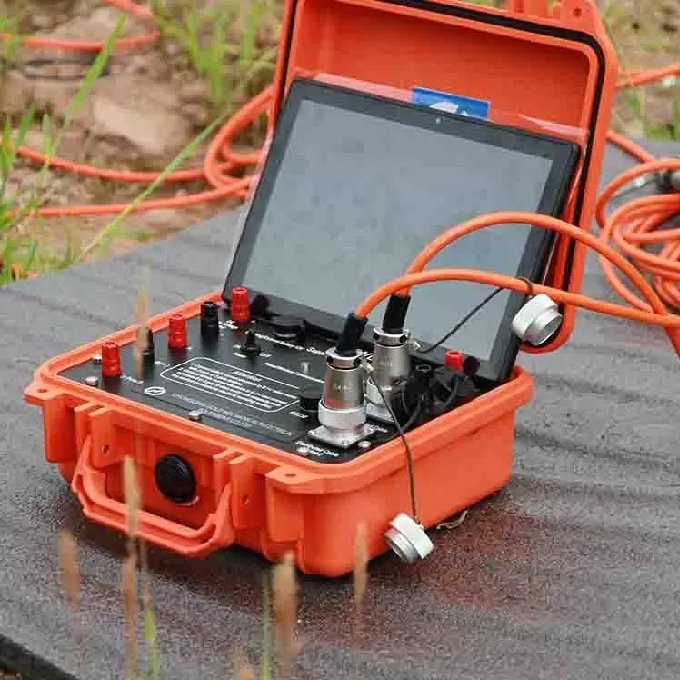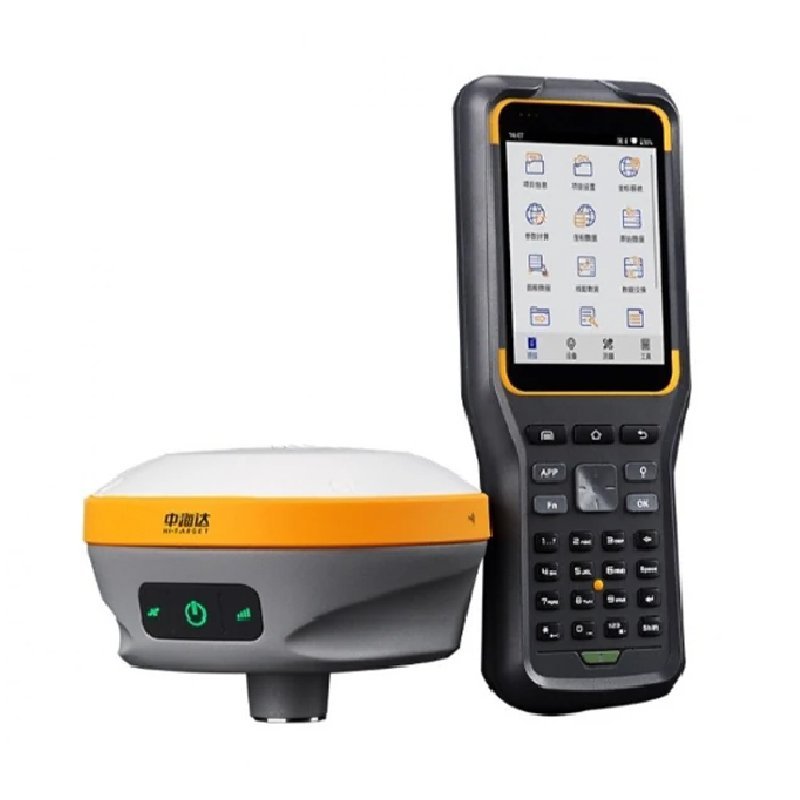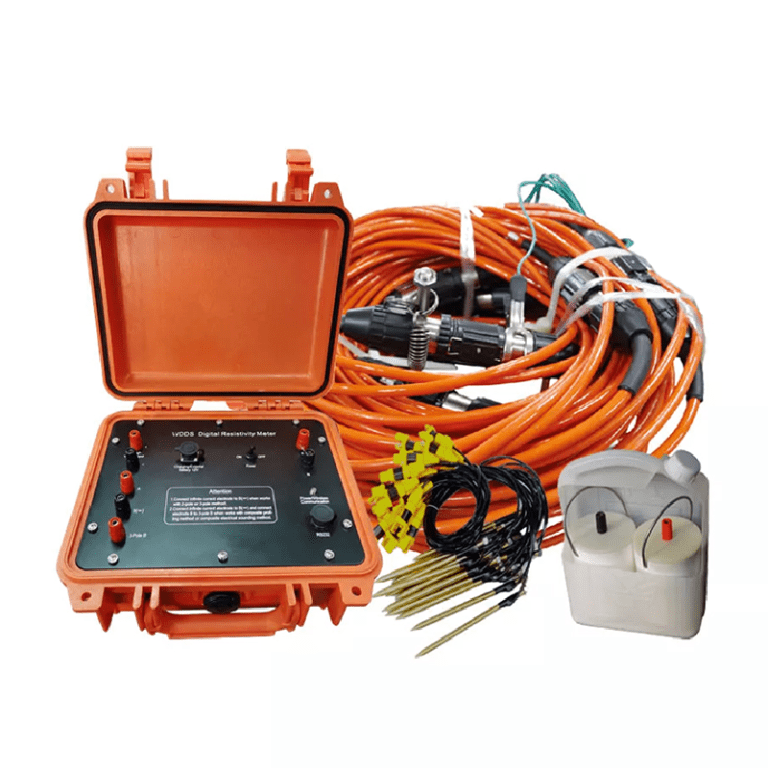Welcome to Geotech!

Electrical & Magnetic instrument Solution :The landfill leakage detection solution
- Solutions, Comprehensive Solutions
- 34 views
Description
Ⅰ.Project introduction
Purpose of the survey: Under non-excavation conditions: assessment of landfill boundary, burial depth, buried volume, landfill leachate seepage and surrounding cultivated land conditions provide reliable information for later construction.
Ⅱ.Investigation method
Detection is performed by inductive electromagnetic (EM) and electrical resistivity (Tomography) using geophysical detection.(The packing density of landfills and the enrichment of leachate in the survey area will cause the difference between the conductivity of the detector and the original rock and soil, which is suitable for the intervention of physical exploration methods).
Ⅲ.On-site program
Equipment
The survey selected Geotech’s WGMD-10V 5-channel distributed high-density electrical measurement system and WCZ-3 GPS Proton Precession Magnetometer. The position information of the measurement points was collected by RTK.

Test program
Reasonable layout of survey lines can ensure the acquisition of high-quality data. The total area of the survey area is 26000m², and a regional grid layout is carried out with a grid spacing of 20-30 meters. A total of 18 ERT survey lines are laid.


Ⅳ.Electric method working principle
Induction electromagnetic works
The main method of induction electromagnetic method (EM) is frequency domain electromagnetic method (FDEM), which generates an induced magnetic field in the formation through the instantaneous current of the coil, and calculates the apparent conductivity of the material by recording the phase difference of the secondary magnetic field. In a fixed case, the two-dimensional tangent plane distribution of the conductivity of the material at a specific depth can be delineated.

It is often presented in the form of a cut plane equivalent image or a single point measurement, depicting the difference in surface electrical distribution, and the conductivity of the physical unit (mS/m), representing different heights and values in different shades.
Electrical resistivity tomography works
The resistivity method is a geophysical method based on the difference in dielectric resistivity. The detection principle of the DC resistance method is to establish an artificial electric field by using a direct current to pass a pair of current poles A and B into the ground. By the difference in conductivity between the interlayer media, another potential pair M, N can be used to measure the potential difference between the electric field between M and N, thereby obtaining the apparent resistivity of the formation and estimating the underground formation. Conductivity distribution.


Ⅴ.Results show
EM Result
The figure shows that the overall conductivity of the survey area is high, and the detection value is about 100-300 ms/m. It is speculated that the landfill leachate in this field has spread to the whole area, and the high conductivity in the area (>500ms/ m) is distributed in the southwest corner. It is speculated that this area is the collection area of landfill leachate. There is no obvious anti-seepage work in this area, and there is a hidden danger of further spread of pollution.

ERT Result

The high-density resistivity method results of the survey area are used to establish a three-dimensional model, and the results of 3D and other deep-section results show that most of the depths of 0 to 15 meters are low-resistivity formations, and the resistivity values are lower than 20 Ohm-m; >15 meters. The formation resistivity has begun to rise; the depth of 18-20 meters is the original formation, and there is no landfill resistivity characteristic. The volume of waste is estimated to be 300,000 to 350,000 cubic meters.
Ⅵ.Advantages of geophysical methods
The plane distribution range of the abnormal value of the measurement area is determined by the inductive electromagnetic method, and the distribution range of the abnormal value of the measurement area in the vertical direction is determined by the high-density resistivity method. The two methods are closely matched to obtain the geological body in the space of the measurement area. Characteristic parameter.
The traditional way of investigating is to estimate the possible distribution through limited borehole sampling, and to estimate the extent and depth of the pollution distribution through the correlation of the results between the points; the geophysical prospecting is non-destructive. The method of measuring the landfill and stratum structure under the ground, in addition to the characteristics of no drilling, can also obtain continuous profile data through a wide range of measurements.
Geophysical methods investigate contaminated sites, no holes are exposed, prevent further spread of pollution, environmental protection, and no secondary pollution.
FAQ
The double tap has a large current and can be used for IP testing to get more accurate data.
High-density apparent resistivity method is an array prospecting method, also known as automatic apparent resistivity system, which is developed from direct current method. Its function is equivalent to the combination of quadrupole sounding and electrical profiling method. The artificial electric field is formed by supplying electricity to the underground through electrodes. The distribution of the electric field is closely related to the distribution of the resistivity of the underground rock and soil medium. By measuring the artificial electric field at different parts of the surface, the distribution of the apparent resistivity of the underground medium is understood, and the underground geological structure is inferred and interpreted based on the distribution of the apparent resistivity of the rock and soil medium.
The principle of high-density electrical method is the same as that of traditional resistivity method. It is a combination method of multiple devices and multiple pole distances that integrates electrical depth sounding and electrical profiling method, which can obtain the conductivity characteristics of two-dimensional underground media. It has the characteristics of multi-device data acquisition in one pole arrangement, and highlighting abnormal information by obtaining ratio parameters, which greatly increases the amount of collected data, improves work efficiency, and ensures the accuracy and reliability of the pole running process.
This method is particularly sensitive to the water content of the surrounding rock. If the surrounding rock is broken and contains water, its apparent resistivity is significantly reduced. The apparent resistivity of intact and hard rock and soil is significantly higher than that of the surrounding rock in the fault zone or broken zone and water-rich zone. This method has a clear principle and intuitive images. It is a geophysical method with high resolution. In recent years, with the improvement of computer data acquisition technology, the exploration efficiency has been greatly improved, the coverage area and detection depth of the profile have been increased, reliable data can be obtained in a strong interference environment, the signal-to-noise ratio has been greatly improved, and the geological body can be accurately detected. This method has been widely and successfully applied in engineering and hydrogeological exploration and exploration of mineral and water resources.
(1) Application in coalfield and mine goaf detection
(2) Non-destructive detection of termite nests in dam foundations
(3) Karst and foundation surveys of railways, roads and tunnels
(4) Delineation of stratum lithology boundaries
(5) Survey of the leakage range of landfills
(6) Ancient tomb surveys
(7) Detection of sewage pipes
(8) Non-destructive testing of leakage in reservoirs and river dams
(9) Detection of bedrock fracture zones
(10) Soil salinity and water quality surveys
(11) Detection of ancient tunnels, air-raid shelters, metal burial sites, etc.
(1)The high-density resistivity method is based on the resistivity method, so it is suitable for all underground explorations with obvious conductivity differences;
(2)Any medium underground will have a weak polarization potential at the moment of power on and off, which will affect our measurement of the true potential difference. When the electrode distance is small, the loop current is large, which has little effect on the measurement results; when the electrode distance is too large, the interference potential is close to the effective potential, which has a greater impact on the measurement results. Therefore, due to the influence of the power supply electrode distance, the exploration depth cannot be too large, generally within 100m. When the conductivity of the soil medium is good, it can be appropriately increased, and the exploration depth in the soil medium with poor conductivity is appropriately smaller;
(3)It is generally less used in cities, near large transmission lines, etc. due to site restrictions and industrial stray current interference; 4. In areas such as concrete pavements and exposed bedrock surfaces, it is also less used due to the difficulty of electrode layout.
-1.png)







